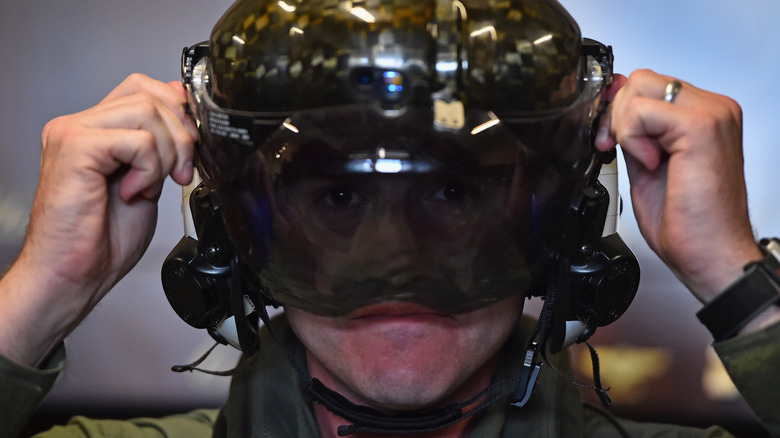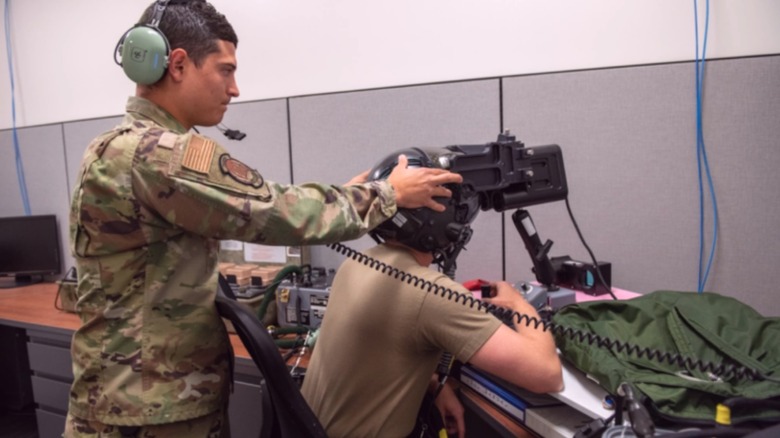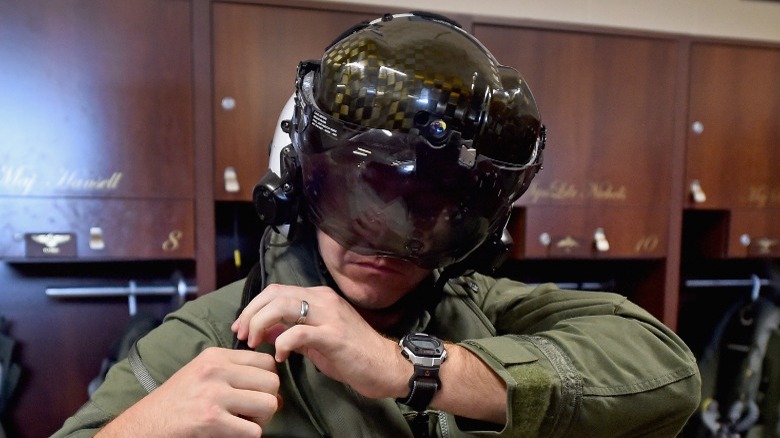Here's What Makes The F-35 Pilot Helmet So Unique
The Lockheed Martin F-35 Lightning II is the most advanced single-engine stealth combat aircraft ever built. It is a marvel of avionic engineering, and since it entered active service in 2015, it has proven its effectiveness in and out of combat operations for the United States and its allies. When people think of the F-35, they likely picture the aircraft while considering its many capabilities, like the plane's lightning speed, while some may picture the pilots and the training they require to operate such an advanced aircraft.
An afterthought might find its way to the helmet those pilots wear whenever they fly an F-35. That helmet is a feat of engineering unlike any pilot's helmet that preceded it, and while it may not look like much, a ton of technology is packed inside. The F-35 doesn't have a canopy heads-up display (HUD) — that information is instead displayed in real-time on the helmet's visor, offering a more immersive experience that extends the pilot's combat capabilities through vision.
On top of that, pilots don't simply go to a bin and pull out a helmet before each flight; each helmet is personally fitted to every pilot. This makes each helmet, known as the Collins Aerospace F-35 Helmet Mounted Display System (HMDS), unique to the pilot using them. Each helmet fits perfectly to increase a pilot's situational analysis, flight safety, and visual accuracy, as they also use the HUD for targeting. A pilot can utilize the F-35's tracking system to lock onto a target by visually looking at an enemy aircraft.
F-35 HMDS uses advanced technology
The F-35 is a fifth-generation fighter, and the helmet was designed with this in mind. The purpose of its integrated HUD and connection to the aircraft is simple: Everything related to flight and mission data appears on the display. This gives the pilot a 360-degree view of the battlespace by projecting everything around the plane to the pilot. If they look down at their legs, they will only see the terrain below their aircraft as if they're flying Wonder Woman's invisible jet, though this is somewhat limited.
Tech. Sgt. William Vass of the 419th Fighter Wing explained to the Air Force, "The pilot can look down through a portion of their wing and see what's below. When they look toward the cameras embedded on the F-35 that image projects onto their helmet display."
The role of the HDMS is to unite the pilot with their aircraft in ways never conceived of before. It includes a visor and bi-optical HUD with integrated night vision and image overlays. Each helmet is fitted to the pilot's head and interpupillary distance, providing the best possible vision interface for each pilot. The helmet is fitted so perfectly that a change in pilot hairstyle requires a refitting — it's that precise.
Fitting a pilot with an HDMS is a two-day process carried out by U.S. Air Force personnel. The fitting begins by measuring every aspect of a pilot's head, including the distance between their pupils, ensuring their bi-optical HUD appears as a single image.
The F-35 helmet is costly
The F-35's HDMS is a unique piece of technology, as each is fitted to a single user. If you think this runs up the cost, you're right. A single helmet costs the military $400,000, making it more expensive than many luxury cars. The helmet's development wasn't a one-and-done process, as it's gone through several upgrades since its introduction. The current helmet introduced in 2016 is a third-generation model.
The Gen III F-35 HDMS features several upgrades, including improvements to its night vision camera, software enhancements, automated alignment, and liquid crystal displays. The Gen III helmet is the result of design changes initially planned for an alternate Gen II HDMS. The Pentagon's F-35 Joint Program Office (JPO) scrapped plans to produce an entirely new helmet proposed by BAE, preferring to bring the then-current design up to Gen III requirements. It's unclear what the total program cost of the new helmet development was, but the JPO's upgrade strategy cut costs by 12%, saving the government $45 million in development costs for a new helmet.
This aligns with the total cost of a production contract for the Gen III HDMS for the F-35, which the U.S. Navy awarded for $347.4 million in mid-2023. Because the helmets are uniquely fitted to pilots, they don't get to use one in flight school or training; instead, they use mockups. Pilots don't receive their helmets until they're assigned to an active F-35 squadron. Despite this, each aircraft requires two to four helmets due to wear and tear and the rotation of pilots in and out of a squadron.


